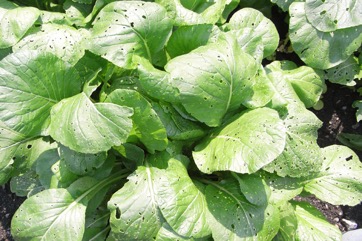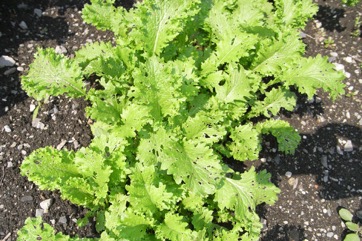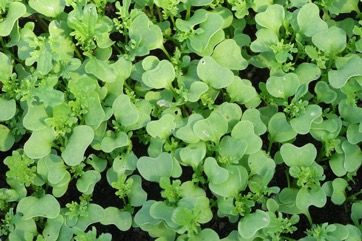Indian mustard, Leaf mustard, Chinese mustard

A warm temperate plant. It is grown in some highland areas in the tropics. It is often grown as a cool season crop. Most varieties are not frost tolerant. It needs a fertile, well drained soil. A pH of 5.5-6.8 is suitable. It can tolerate poor soils. In the Himalayas in summer it grows to 3,600 m altitude. It can grow in arid places. It suits hardiness zones 9-11. Tasmania Herbarium. In Yunnan.
Also known as:
Acelga china, A-mothsora, Ananatsongo, Antam, Brown mustard, Cai be-xanh, Cai canh, Dijon mustard, Figiri, Gai choi, Jie cai, Kaad khiew, Kaai ts'oi, Kabej-plasas, Kadugu, Kai choy, Karamkala, Kanganje, Karashi-na, Khat naa, Mbumbi, Modo metan, Monnyin-no, Mosita, Mostaza china, Mpatu, Mpiru, Mustasa, Nkofi, Phakkat-khieo, Phakkat-khieopli, Rai, Rai sorisha, Samon-ni, Sawi, Sawi pahit, Se-sawi
Synonyms
- Brassica argyi H. Léveillé
- Brassica cernua (Thunberg) F. B. Forbes & Hemsley
- Brassica integrifolia (West) O. E. Schulz
- Brassica japonica (Thunberg) Siebold ex Miquel
- Brassica juncea subsp. integrifolia (West) Thellung
- Brassica juncea var. crispifolia L. H. Bailey
- Brassica juncea var. foliosa L. H. Bailey
- Brassica juncea var. gracilis M. Tsen & S. H. Lee
- Brassica juncea var. integrifolia (Stokes) Sinskaya
- Brassica juncea var. japonica (Thunberg) L. H. Bailey
- Brassica juncea var. longidens L. H. Bailey
- Brassica juncea var. longipes M. Tsen & S. H. Lee
- Brassica juncea var. multisecta L. H. Bailey
- Brassica juncea var. multiceps M. Tsen & S. H. Lee
- Brassica juncea var. rugosa (Rox-burgh) Kitamura
- Brassica juncea var. strumata M. Tsen & S. H. Lee
- Brassica juncea var. subintegrifolia Sinskaya
- Brassica lanceolata (de Candolle) Lange
- Brassica napiformis (Paillieux & Bois) L. H. Bailey var. multisecta (L. H. Bailey) A. I. Baranov
- Brassica rugosa (Rox-burgh) L. H. Bailey
- Brassica taquetii H. Léveillé
- Brassica willdenowii Boissier
- Raphanus junceus (Linnaeus) Crantz
- Sinapis cernua Thunberg
- Sinapis chinensis Linnaeus var. integrifolia Stokes
- Sinapis cuneifolia Roxburgh
- Sinapis integrifolia West
- Sinapis japonica Thunberg
- Sinapis juncea Linnaeus
- Sinapis lanceolata de Candolle
- Sinapis patens Roxburgh
- Sinapis ramosa Roxburgh
- Sinapis rugosa Roxburgh
Edible Portion
- Leaves, Seeds - oil, Spice, Vegetable, Flowers
Where does Indian mustard grow?
Found in: Afghanistan, Africa, Argentina, Asia, Australia, Austria, Bangladesh, Bhutan, Botswana, Brazil, Britain, Bulgaria, Cambodia, Cameroon, Canada, Caucasus, Central Africa, Central America, Central Asia, China, Congo DR, Costa Rica, Côte d'Ivoire, Cuba, Denmark, East Africa, East Timor, Egypt, Ethiopia, Europe, Fiji, Finland, Germany, Guiana, Guinea, Guinée, Guinea-Bissau, Guyana, Haiti, Hawaii, Himalayas, Hungary, India, Indochina, Indonesia, Iran, Iraq, Ireland, Ivory Coast, Japan, Kenya, Kiribati, Korea, Kuwait, Madagascar, Malawi, Malaysia, Marquesas, Mongolia, Mozambique, Myanmar, Namibia, Nauru, New Caledonia, New Zealand, Nigeria, Norfolk Island, North Africa, North America, Northeastern India, Oman, Pacific, Pakistan, Papua New Guinea, PNG, Paraguay, Philippines, Puerto Rico, Reunion, Romania, Russia, Sao Tome and Principe, Scandinavia, SE Asia, Siberia, Sierra Leone, Sikkim, South Africa, Southern Africa, South America, Spain, Sri Lanka, Sweden, Taiwan, Tanzania, Tasmania, Thailand, Timor-Leste, Trinidad-Tobago, Turkey, Tuvalu, United States, Vanuatu, Vietnam, West Africa, West Indies, Yemen, Zambia, Zimbabwe
Notes: There are about 30 Brassica species and many cultivated varieties.
Status: Only grown occasionally in Papua New Guinea.
Growing Indian mustard, Leaf mustard, Chinese mustard
Cultivation: The seed is broadcast. They can be put in a nursery and transplanted. A spacing of 25 cm x 25 cm is suitable. Seed germinate in 5 days at 20-25°C.
Edible Uses: The leaves are cooked and eaten. They have a bitter taste, so the cooking water needs changing. They can be stir-fried, or added to soups and stews. They can be eaten crystallised in vinegar or salt. They can be used in salads. The seeds can be fried then used as a spice. They also yield an edible oil. They can be sprouted. The leaves are also pickled.
Production: Plants grow rapidly. Leaves can be harvested one month after planting. Leaves can be harvested several times. Whole plants can be harvested in about 45 days from transplanting.
Nutrition Info
per 100g edible portion| Edible Part | Energy (kcal) | Protein (g) | Iron (mg) | Vitamin A (ug) | Vitamin c (mg) | Zinc (mg) | % Water |
|---|---|---|---|---|---|---|---|
| Leaves | 26 | 2.4 | 2.7 | 31 | 73 | - | 92 |
| Seeds | 469 | 24.9 | 10 | - | 3 | - | 6.9 |
| Sprouts | - | - | - | - | - | - |
Indian mustard, Leaf mustard, Chinese mustard Photos



References
Anderson, E. F., 1993, Plants and people of the Golden Triangle. Dioscorides Press. p 204
Ara, R. I. T., 2015, Leafy Vegetables in Bangladesh. Photon eBooks. p 89
Arinathan, V., et al, 2007, Wild edibles used by Palliyars of the western Ghats, Tamil Nadu. Indian Journal of Traditional Knowledge. 6(1) pp 163-168
Bandyopadhyay, S. et al, 2009, Wild edible plants of Koch Bihar district, West Bengal. Natural Products Radiance 8(1) 64-72
Bircher, A. G. & Bircher, W. H., 2000, Encyclopedia of Fruit Trees and Edible Flowering Plants in Egypt and the Subtropics. AUC Press. p 64 (As Brassica besseriana)
Bodkin, F., 1991, Encyclopedia Botanica. Cornstalk publishing, p 168
Bremness, L., 1994, Herbs. Collins Eyewitness Handbooks. Harper Collins. p 234
Brouk, B., 1975, Plants Consumed by Man. Academic Press, London. p 240
Brown, D., 2002, The Royal Horticultural Society encyclopedia of Herbs and their uses. DK Books. p 146
Bull. Soc. Imp. Naturalistes Moscou 33:134. 1860
Burkill, I.H., 1966, A Dictionary of the Economic Products of the Malay Peninsula. Ministry of Agriculture and Cooperatives, Kuala Lumpur, Malaysia. Vol 1 (A-H) p 365
Chin, H. F., 1999, Malaysian Vegetables in Colour. Tropical Press. p 18
Consp. pl. charc. 8. 1859 Mar (E. Cosson, Bull. Soc. Bot. France 6(8):609. 1860 Jan)
Creasy, R., 2000, The Edible Asian Garden. Periplus p 47
Cundall, P., (ed.), 2004, Gardening Australia: flora: the gardener's bible. ABC Books. p 255
Dhyani, S.K., & Sharma, R.V., 1987, Exploration of Socio-economic plant resources of Vyasi Valley in Tehri Garwhal. J. Econ. Tax. Bot. Vol. 9 No. 2 pp 299-310
Duke, J.A., 1992, Handbook of Edible Weeds. CRC Press. p 50
Epenhuijsen C.W. van., 1974, Growing Native vegetables in Nigeria. FAO Rome, p 42
Facciola, S., 1998, Cornucopia 2: a Source Book of Edible Plants. Kampong Publications, p 53
Flora of Australia, Volume 8, Lecythidales to Batales, Australian Government Publishing Service, Canberra (1982) p 238
Flora of Australia Volume 49, Oceanic Islands 1, Australian Government Publishing Service, Canberra. (1994) p 135
Flora of China. www.eFloras.org Volume 8
French, B.R., 1986, Food Plants of Papua New Guinea, A Compendium. Asia Pacific Science Foundation p 114
Grubben, G. J. H. and Denton, O. A. (eds), 2004, Plant Resources of Tropical Africa 2. Vegetables. PROTA, Wageningen, Netherlands. p 123
Guite, C., 2016, A study of wild edible plants associated with the Paite tribe of Manipur, India, International Journal of Current Research. Vol. 8, Issue, 11, pp. 40927-40932
Harkonen, M. & Vainio-Mattila, K., 1998, Some examples of Natural Products in the Eastern Arc Mountains. Journal of East African Natural History 87:265-278
Hedrick, U.P., 1919, (Ed.), Sturtevant's edible plants of the world. p 121
Hemingway, J.S., 1979, Mustards, in Simmonds N.W.,(ed), Crop Plant Evolution. Longmans. London. p 56
Hemphill, I, 2002, Spice Notes. Macmillan. p 249
Hussey, B.M.J., Keighery, G.J., Cousens, R.D., Dodd, J., Lloyd, S.G., 1997, Western Weeds. A guide to the weeds of Western Australia. Plant Protection Society of Western Australia. p 113
Hutton, W., 1997, Tropical Herbs and Spices of Indonesia. Periplus. p 42
Hu, Shiu-ying, 2005, Food Plants of China. The Chinese University Press. p 407
Hwang, H., et al, 2013, A Study on the Flora of 15 Islands in the Western Sea of Jeollanamdo Province, Korea. Journal of Asia-Pacific Biodiversity Vol. 6, No. 2 281-310
Jardin, C., 1970, List of Foods Used In Africa, FAO Nutrition Information Document Series No 2.p 60
Kapelle, M., et al, 2000, Useful plants within a Campesino Community in a Costa Rican Montane Cloud Forest. Mountain Research and Development, 20(2): 162-171.
Khodram,S. D., et al, 2019, Local knowledge of edible flowers used in Mizoram. Indian Journal of Traditional Knowledge Vol 18(40 pp 715-723
Kiple, K.F. & Ornelas, K.C., (eds), 2000, The Cambridge World History of Food. CUP p 1819, 1820
Kumar, S. A., Manus, D. & Mallika, M., 2018, Impact of non-timber forest products on Forest and in Livelihood Economy of the People of Adjoining Areas of Jalpaiguri Forest Division, West Bengal, India. Int. J. of Life Sciences, 2018; 6 (2):365-385
Kuo, W. H. J., (Ed.) Taiwan's Ethnobotanical Database (1900-2000), http://tk.agron.ntu.edu.tw/ethnobot/DB1.htm
Larkcom, J., 1991, Oriental Vegetables, John Murray, London, p 39
Latham, P., 2004, Useful Plants of Bas-Congo province. Latham & DFID p 55
Latham, P. & Mbuta, A. K., 2014, Useful Plants of Bas-Congo Province, Democratic Republic of Congo. Volume 1. Salvation Army. p 83
Lazarides, M. & Hince, B., 1993, Handbook of Economic Plants of Australia, CSIRO. p 37
Liu, Yi-tao, & Long, Chun-Lin, 2002, Studies on Edible Flowers Consumed by Ethnic Groups in Yunnan. Acta Botanica Yunnanica. 24(1):41-56
Low, T., 1991, Wild Herbs of Australia and New Zealand. Angus & Robertson. p 51 (Drawing)
Low, T., 1992, Bush Tucker. Australia’s Wild Food Harvest. Angus & Robertson. p
Malaisse, F., 1997, Se nourrir en floret claire africaine. Approche ecologique et nutritionnelle. CTA., p 59
Malaisse, F., 2010, How to live and survive in Zambezian open forest (Miombo Ecoregion). Les Presses Agronomiques de Gembloux.
Malezas Comestibles del Cono Sur, INTA, 2009, Buernos Aires
Martin, F.W. & Ruberte, R.M., 1979, Edible Leaves of the Tropics. Antillian College Press, Mayaguez, Puerto Rico. p 110, 188, p 187 (As Brassica rugosa)
Miguel, E., et al, 1989, A checklist of the cultivated plants of Cuba. Kulturpflanze 37. 1989, 211-357
Ochse, J.J. et al, 1931, Vegetables of the Dutch East Indies. Asher reprint. p 163
Paczkowska, G. & Chapman, A.R., 2000, The Western Australian Flora. A Descriptive Catalogue. Western Australian Herbarium. p 185
Polunin, O., & Stainton, A., 2006, Flowers of the Himalaya, Oxford India Paperbacks. p 43
PROSEA handbook Volume 13 Spices. p 274
Mulherin, J., 1994, Spices and natural flavourings. Tiger Books, London. p 62
Omawale, 1973, Guyana's edible plants. Guyana University, Georgetown p 97
Oomen, H.A.P.C., & Grubben, G.J.H., 1978, Tropical Leaf Vegetables in Human Nutrition, Communication 69, Department of Agricultural research, RTI Amsterdam, p 36, 66, 89
Pham-Hoang Ho, 1999, An Illustrated Flora of Vietnam. Nha Xuat Ban Tre. p 603
Phon, P., 2000, Plants used in Cambodia. © Pauline Dy Phon, Phnom Penh, Cambodia. p 101
Plants for a Future database, The Field, Penpol, Lostwithiel, Cornwall, PL22 0NG, UK. http://www.scs.leeds.ac.uk/pfaf/
Plants of Haiti Smithsonian Institute http://botany.si.edu
Purseglove, J.W., 1968, Tropical Crops Dicotyledons, Longmans. p 91
Ramachandran,V. S., & Udhayavani, C., 2013, Knowledge and uses of wild edible plants by Paniyas and Kurumbas of Western Nilgiris, Tamil Nadu. Indian Journal of Natural Products and Resources. 4(4) December 2013, pp 412-418
Rasingam, L., 2012, Ethnobotanical studies on the wild edible plants of Irula tribes of Pillur Valley, Coimbatore district, Tamil Nadu, India. Asian Pacific Journal of Tropical Biomedicine. (2012) S1493-S1497
Royal Botanic Gardens, Kew (1999). Survey of Economic Plants for Arid and Semi-Arid Lands (SEPASAL) database. Published on the Internet; http://www.rbgkew.org.uk/ceb/sepasal/internet [Accessed 15th April 2011]
Sarvalingam, A., et al, 2014, Wild edible plant resources used by the Irulas of the Maruthamalai Hills, Southern Western Ghats, Coimbatore, Tamil Nadu. Indian Journal of Natural Products and Resources 5(2):198-201
Schippers, R.R. & Mnzava, N.A., 2007. Brassica juncea (L.) Czern. [Internet] Record from Protabase. van der Vossen, H.A.M. & Mkamilo, G.S. (Editors). PROTA (Plant Resources of Tropical Africa), Wageningen, Netherlands. < http://database.prota.org/search.htm>. Accessed 14 October 2009.
Schneider, E., 2001, Vegetables from Amaranth to Zucchini: The essential reference. HarperCollins. p 396
Seidemann J., 2005, World Spice Plants. Economic Usage, Botany, Taxonomy. Springer. p 69
Shava, S., et al, 2009, Traditional food crops as a source of community resilience in Zimbabwe. International Journal of the African Renaissance 4(1)
Siemonsma, J. S. and Piluek, K. (Eds), 1994, Plant Resources of South-East Asia No. 8 Vegetables. Prosea Foundation, Bogor, Indonesia, p 104
Small, E., 2009, Top 100 Food Plants. The world's most important culinary crops. NRC Research Press. p 362
Smith, K., 1998. Growing Uncommon Fruits and Vegetables. New Holland. p 57
Solomon, C., 2001, Encyclopedia of Asian Food. New Holland. p 59, p 241
Tasmanian Herbarium Vascular Plants list p 16
Terra, G.J.A., 1973, Tropical Vegetables. Communication 54e Royal Tropical Institute, Amsterdam, p 31 (Also as Brassica rugosa)
Thaman, R. R., 1987, Plants of Kiribati: A listing and analysis of vernacular names. Atoll Research Bulletin No. 296
Thaman, R. R, 2016, The flora of Tuvalu. Atoll Research Bulletin No. 611. Smithsonian Institute p 73
Thokchom, R., et al, 2016, Documentation and assessment of wild medicinal and edible flowers of valley districts of Manipur. International Journal of Research in Applied, Natural and Social Sciences. 4(11):13-20
Thomson, G. & Morgan, W., (Ed.) 2002, Access to Asian Foods Newsletter, Vic Govt., Australia Issue 53
Tindall, H.D., 1983, Vegetables in the tropics. Macmillan p. 113
Tredgold, M.H., 1986, Food Plants of Zimbabwe. Mambo Press. p 38
Tronickova, E. & Krejcova, Z., 1987, Ortaggi, Instituto Geografico de Agostini, Cecoslovacchia. p 86 (As Sinapis chinensis)
Tyagi, R. K., et al, 2004, Conservation of Spices Germplasm in India. Indian J. Plant Genet. Resour. 17(3): 163-174
Urgamal, M., Oyuntsetseg, B., Nyambayar, D. & Dulamsuren, Ch. 2014. Conspectus of the vascular plants of Mongolia. (Editors: Sanchir, Ch. & Jamsran, Ts.). Ulaanbaatar, Mongolia. “Admon“ Press. 334pp. (p. 79-90).
Van Sam, H. et al, 2008, Uses and Conservation of Plant Species in a National Park. A case study of Ben En, Vietnam. Economic Botany 62:574-593
van Wyk, B., 2005, Food Plants of the World. An illustrated guide. Timber press. p 95
Walter, A. & Lebot, V., 2007, Gardens of Oceania. ACIAR Monograph No. 122. p 235
Williamson, J., 2005, Useful Plants of Malawi. 3rd. Edition. Mdadzi Book Trust. p 43
Woodward, P., 2000, Asian Herbs and Vegetables. Hyland House. p 35
World Checklist of Useful Plant Species 2020. Royal Botanic Gardens, Kew
Yeshi, K. et al, 2017, Taxonomical Identification of Himalayan Edible Medicinal Plants in Bhutan and the Phenolic Contents and Antioxidant Activity of Selected Plants. TBAP 7 (2) 2017 pp 89 - 106
Zhang, L., et al, 2016, Ethnobotanical study of traditional edible plants used by the Naxi people during droughts. Journal of Ethnobiology and Ethnomedicine. 12:39
Zhou Taiyan, Lu Lianli, Yang Guang, Ihsan A. Al-Shehbaz, BRASSICACEAE (CRUCIFERAE), Flora of China.